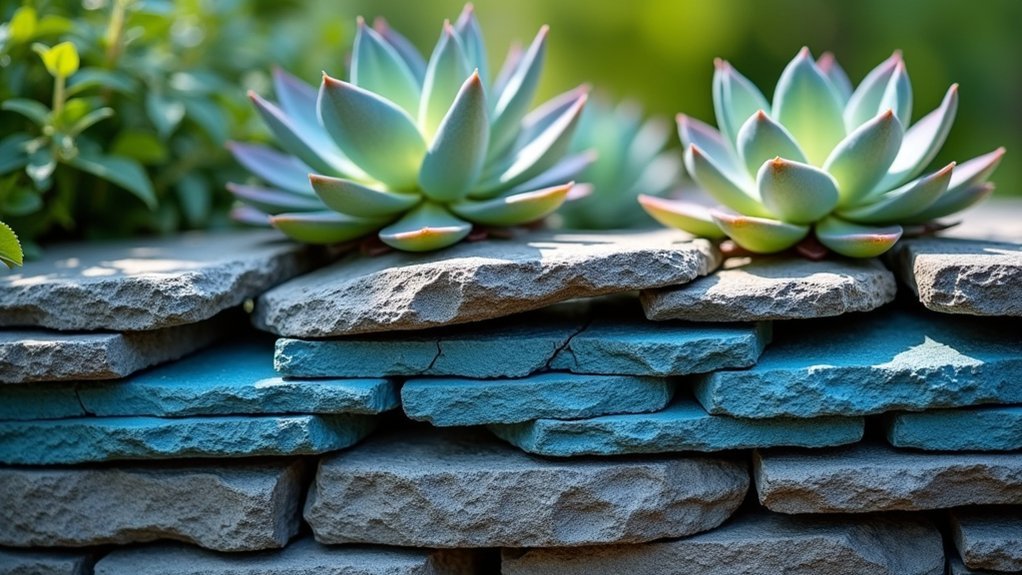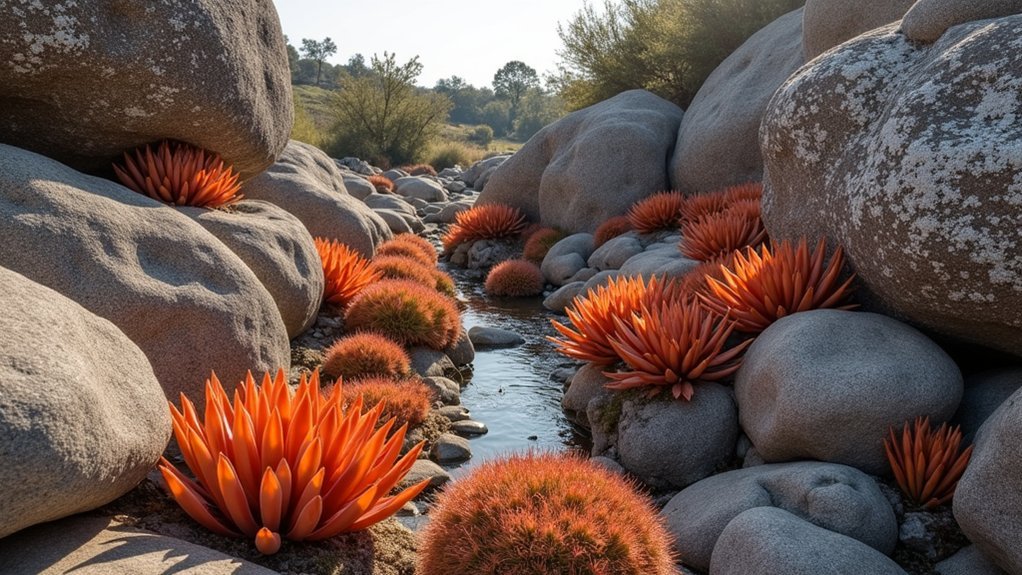Stone-succulent borders create natural boundaries while adding visual interest to your landscape. You’ll love these seven options: layered river rock with sedum, desert-inspired agave with sandstone, limestone pathways, stacked slate with blue chalksticks, gabion walls with planting pockets, weathered boulder with copper stonecrop, and zen garden borders with graptoveria. Each design combines drought-resistant plants with distinctive stones for low-maintenance, beautiful shifts between garden areas. These natural combinations offer both functionality and contemporary aesthetic appeal.
Layered River Rock and Sedum Border Design

While many garden borders rely solely on plants or hardscaping elements, a layered river rock and sedum combination offers the best of both worlds. This design creates visually appealing shifts between garden areas while providing the excellent drainage that sedum plants need to thrive.
Choose river rocks in varying sizes to add texture and depth to your border. The smooth, rounded edges contrast beautifully with the thick, pointed leaves of sedum, creating a dynamic visual effect that draws the eye along your garden’s boundaries.
Your succulent garden will benefit from this pairing, as sedum requires minimal watering and tolerates dry conditions perfectly. This natural-looking combination prevents soil erosion effectively, making it ideal for sloped areas or garden beds that need well-defined, low-maintenance edges.
Desert-Inspired Agave and Sandstone Perimeters
Creating desert-inspired borders with agave and sandstone offers you a striking shift between your garden’s distinct zones.
You’ll find these xeriscaping elements particularly effective in arid regions, where their drought-resistant qualities complement the natural landscape while reducing water consumption.
The warm tones of sandstone paired with the architectural forms of Blue Glow or attenuata agave species bring authentic Southwest landscape aesthetics to your garden perimeter.
Transitional Xeriscaping Elements
Modern landscapes demand sustainable solutions that merge beauty with practicality. Evolving xeriscaping offers the perfect balance by incorporating desert-inspired elements into your garden design while dramatically reducing water consumption.
You’ll create stunning borders using Agave species like Blue Glow and attenuata paired with natural sandstone perimeters, defining your planting areas with architectural interest.
- Combine succulents and cacti with varying heights and textures for visual dimension
- Use decorative rocks in complementary colors to enhance your landscape design
- Arrange sandstone pieces to create natural-looking borders that frame your plantings
- Select drought-tolerant plants that provide year-round interest with minimal maintenance
This approach not only conserves water but also attracts local wildlife, supporting biodiversity while giving your garden distinctive character and sustainable elegance.
Southwest Landscape Integration
The timeless beauty of Southwest landscape design emerges naturally when you pair desert-inspired agave varieties with carefully positioned sandstone perimeters. Striking specimens like Agave Blue Glow and Agave attenuata create dramatic focal points in your rock garden while maintaining minimal water requirements.
You’ll find that locally sourced sandstone creates a seamless connection between hardscape and natural surroundings, especially when arranged in structured patterns that highlight your succulents’ unique forms. This intentional framework elevates your desert landscape beyond simple xeriscaping to an artistic composition.
For maximum impact with minimal maintenance, integrate drought-resistant varieties like Sedum nussbaumerianum and Senecio mandraliscae alongside your sandstone borders. Their earthy tones complement the natural stone, creating a cohesive aesthetic that’s both water-wise and visually stunning in arid environments.
Multi-Textured Limestone and Succulent Pathways

You’ll discover endless design possibilities when layering multi-textured limestone with various succulent varieties along your garden pathways.
Create winding paths with intentional curves that lead the eye through your landscape while incorporating different sizes of limestone to add visual interest and practical functionality.
Your climate-proof design will thrive through changing seasons when you pair drought-tolerant succulents with limestone’s natural drainage properties, ensuring a low-maintenance yet stunning outdoor feature.
Texture Layering Techniques
Creating dynamic pathways with multi-textured limestone and succulents elevates your garden’s visual interest through strategic contrast.
By implementing texture layering techniques with rocks and succulents, you’ll transform ordinary garden space into an eye-catching landscape that mimics natural riverbed formations.
- Combine larger limestone boulders with smaller pebbles to establish natural flow and improve drainage.
- Position light-colored stones strategically to reflect sunlight and highlight your succulents’ vibrant colors.
- Layer different stone sizes in graduated heights to create depth while preventing soil erosion.
- Arrange succulents with varying leaf shapes along borders to complement the rugged texture of limestone.
This intentional layering creates visual rhythm throughout your pathway, guiding visitors through your garden while providing practical benefits like improved drainage and reduced maintenance.
Winding Path Essentials
Winding garden paths adorned with multi-textured limestone and strategic succulent plantings transform ordinary walkways into enchanting journeys through your landscape.
The natural, rustic look of limestone provides excellent drainage while creating visual interest through varying shapes and sizes that enhance the meandering effect.
You’ll find that succulents thrive alongside these pathways as the limestone retains heat, promoting growth in sunny areas of your landscape.
For maximum impact, incorporate smaller varieties like Sedum or Crassula to create vibrant borders that contrast beautifully with the decorative rocks.
When installing your path, leave adequate spacing between limestone pieces to simplify maintenance and allow room for complementary groundcover plants.
This thoughtful combination of textures creates a practical pathway that doubles as a stunning landscape feature with minimal water requirements.
Climate-Proof Design Tips
While many garden elements struggle with extreme weather conditions, multi-textured limestone pathways paired with strategic succulent plantings stand resilient against climate fluctuations.
You’ll find that locally-sourced stone adapts better to your region’s specific weather patterns, ensuring your pathway design maintains its integrity year-round.
When creating your climate-proof borders, consider these essential elements:
- Layer different limestone sizes to improve drainage and prevent erosion during heavy rainfall
- Select succulents that complement your stone colors, creating visual contrast that highlights both elements
- Position drought-resistant varieties along path edges where they’ll thrive with minimal maintenance
- Incorporate varying stone textures to prevent slippery surfaces in humid or rainy climates
This thoughtful combination of stone and succulents creates not just a boundary, but a durable landscape feature that withstands whatever weather comes your way.
Stacked Slate With Cascading Blue Chalksticks

When you pair stacked slate with cascading Blue Chalksticks, you’ll create a dramatic border that combines rugged structure with flowing softness. The silvery-blue, finger-like foliage elegantly spills over the natural stone edges, creating an eye-catching contrast between textures.
This drought-tolerant combination offers both beauty and practicality. The slate provides excellent drainage that these succulents crave, while establishing clear boundaries between garden areas.
| Benefit | Slate | Blue Chalksticks |
|---|---|---|
| Texture | Rough, structured | Soft, flowing |
| Color | Gray to black | Silvery-blue |
| Maintenance | One-time setup | Minimal watering |
| Longevity | Permanent | Perennial growth |
You’ll appreciate how these materials complement each other while creating a natural-looking border that requires minimal upkeep and thrives in challenging conditions.
Gabion Wall Borders With Integrated Planting Pockets
Gabion walls offer a striking alternative to traditional garden borders, combining industrial-style wire cages filled with stones and cleverly designed planting pockets for succulents.
You’ll appreciate how these structures provide exceptional drainage for your drought-tolerant plants while creating a modern yet rustic boundary for your landscape.
- Create diverse heights and shapes to suit your specific garden design needs
- Incorporate various succulent species within the stone-filled cages for vibrant texture contrasts
- Enjoy minimal maintenance as excess water flows freely through the stone gaps
- Benefit from added soil stability and erosion control, especially in sloped areas
These eco-friendly borders don’t just define your garden—they transform it into a living sculpture that blends natural elements with contemporary design, proving both functional and visually appealing year-round.
Weathered Boulder and Copper Stonecrop Boundaries

Combining nature’s artistry with deliberate design, weathered boulder and Copper Stonecrop boundaries create striking garden transformations that evolve with the seasons.
These rugged stone elements provide natural shifts between planting zones while adding textural depth to your landscape.
Weathered stones create visual rhythm in gardens, forming natural transitions that enhance dimension and character.
You’ll appreciate how Copper Stonecrop’s low-growing habit complements the weathered boulders, its leaves shifting from green to copper-orange depending on sun exposure.
This pairing isn’t just visually appealing—it’s practical too. The boulders divert excess water away from the succulent roots, creating ideal growing conditions that mimic natural habitats.
This combination offers remarkable low maintenance benefits, as both components thrive in drought conditions.
You’re fundamentally creating a self-sustaining microenvironment that needs minimal attention while delivering maximum visual impact throughout the year.
Miniature Zen Garden Borders With Graptoveria Accents
Transforming your garden’s edge into a meditative sanctuary, miniature Zen garden borders with Graptoveria accents offer a perfect blend of serenity and living color.
You’ll find these compact succulents thrive in the well-draining sandy soil that’s essential for any low-maintenance Zen garden design.
- Place light-colored decorative stones around your Graptoveria to create striking contrast that enhances their vibrant rosettes.
- Arrange stones in flowing patterns to encourage mindfulness and create a peaceful focal point.
- Take advantage of Graptoveria’s compact size for easy arrangement in confined border spaces.
- Use the natural interplay between succulent and stone to reflect light beautifully throughout your garden.
This minimalist approach creates boundaries that aren’t just physical dividers but contemplative spaces that invite moments of tranquility in your outdoor environment.
Frequently Asked Questions
How Often Should Stone-Succulent Borders Be Watered?
You’ll only need to water your stone-succulent borders every 2-3 weeks during growing season and monthly in winter. They’re drought-tolerant, so let the soil dry completely between waterings to prevent rot.
Can Stone-Succulent Borders Thrive in Cold Climate Regions?
Stone-succulent borders struggle in cold climates. You’ll need to choose cold-hardy varieties like Sempervivum and Sedum. They’ll survive freezing temperatures, but you’ll need to protect them from excessive moisture during winter.
What Maintenance Is Required for These Borders During Different Seasons?
You’ll need minimal watering in summer, none in winter. Remove debris in fall. Protect tender succulents from frost. Spring requires light pruning and fertilizing. Check for pests year-round. They’re generally low-maintenance borders.
Are Stone-Succulent Borders Pet and Child-Friendly?
Stone-succulent borders are generally child-friendly, but you’ll need to watch for sharp edges on stones. They’re mostly pet-safe, though some succulents are toxic if eaten. Supervise young children and curious pets around them.
How Do You Prevent Weeds in Stone-Succulent Border Installations?
You’ll prevent weeds in stone-succulent borders by installing quality landscape fabric underneath, using polymeric sand between stones, maintaining proper plant spacing, and occasionally spot-treating with vinegar or hand-pulling any persistent weeds that emerge.
In Summary
Stone-succulent borders offer you the perfect blend of structure and living beauty for your landscape. They’ll withstand harsh conditions while requiring minimal maintenance—ideal for busy gardeners or challenging sites. Whether you’re creating property boundaries, defining garden rooms, or highlighting pathways, these natural combinations bring texture, color, and year-round interest to your outdoor spaces. Start with one design that speaks to your aesthetic, then watch your sustainable border thrive.





Leave a Reply